Why Specialized Small Language Models (SLMs) Are Winning in AI Workflows
Bigger isn’t always better in AI. While large language models (LLMs) dominate the headlines, many organizations are shifting toward smaller, specialized language models (SLMs) for real-world workflows. Here’s why the trend is accelerating.
Efficiency and Cost Control
SLMs require far less compute and memory than LLMs, reducing infrastructure costs, latency, and energy use. They can be trained and deployed quickly (ideal for teams running AI in production or at the edge). For companies managing multiple AI agents, workflows, or customer-facing apps, these efficiency gains translate directly into lower operating costs and faster response times.
Domain Specialization
A smaller model trained or fine-tuned on a focused dataset often outperforms a general model on that task. By narrowing scope, SLMs avoid unnecessary reasoning and reduce hallucinations. In practice, this means more predictable results for things like customer-support classification, compliance reviews, or document summarization, without needing a massive model in the loop.
Privacy and Deployment Flexibility
Because they’re lightweight, SLMs can run locally or on-premise instead of relying on external APIs. That’s critical for industries where data sovereignty, latency, or network control matter, such as healthcare, utilities, legal, or contact centers. Running models inside the enterprise network provides privacy, control, and consistent performance.
Faster Iteration and Maintenance
Updating a small model is cheaper and easier than retraining an LLM. Organizations can fine-tune frequently, adapt to new data, and keep workflows current without the overhead of large-scale retraining cycles. This aligns well with continuous-integration practices in MLOps.
Hybrid Workflows
The most effective AI architectures now combine both: SLMs for specialized or high-volume tasks and LLMs for reasoning, creativity, or open-ended questions. In a multi-agent system, for example, smaller models can handle summarization, sentiment analysis, or bias detection, while a larger model orchestrates or fills gaps in context.
The Bottom Line
Small, domain-specific language models deliver speed, control, and cost efficiency where it matters most. They’re not a replacement for large models, but they are often the right tool for production workflows that value privacy, predictability, and scalability. The future of enterprise AI looks less like one giant model and more like a network of smaller, purpose-built ones working together.







